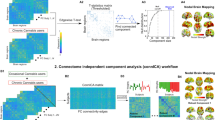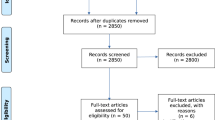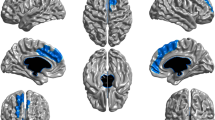Abstract
Active compounds in cannabis such as tetrahydrocannabinol (THC) interact with the inhibitory neurotransmitter δ-aminobutyric acid (GABA) but little is known about the functional effects of cannabis on human cortical brain processes. Therefore, the aim of the study was to investigate whether patients with chronic cannabis use demonstrate abnormalities in cortical inhibition or excitability. In all, 42 chronic cannabis using subjects (divided into heavy and light using subjects) and 19 controls were included in the study. Single and paired pulse transcranial magnetic stimulation were used to assess a number of parameters of cortical inhibition and cortical excitability. In addition, psychomotor function and THC plasma levels were measured. Both cannabis using groups (heavy and light use) demonstrated a reduction in short interval cortical inhibition compared with healthy controls, but there was no difference in other measures of cortical inhibition or cortical excitability. There was also no difference between the two groups on measures of psychomotor performance. Chronic cannabis use is associated with a reduction in cortical inhibition potentially related to activity at the GABAA receptors. Further research is required to explore whether this results from chronic cannabis use or reflects an underlying predisposition to developing chronic substance use problems.
Similar content being viewed by others
Log in or create a free account to read this content
Gain free access to this article, as well as selected content from this journal and more on nature.com
or
References
Andreasson S, Allebeck P, Engstrom A, Rydberg U (1987). Cannabis and schizophrenia. A longitudinal study of Swedish conscripts. Lancet 2: 1483–1486.
Bersani G, Orlandi V, Kotzalidis GD, Pancheri P (2002). Cannabis and schizophrenia: impact on onset, course, psychopathology and outcomes. Eur Arch Psychiatry Clin Neurosci 252: 86–92.
Block RI, Ghoneim MM (1993). Effects of chronic marijuana use on human cognition. Psychopharmacology (Berl) 110: 219–228.
Bolla KI, Brown K, Eldreth D, Tate K, Cadet JL (2002). Dose-related neurocognitive effects of marijuana use. Neurology 59: 1337–1343.
Boutros NN, Lisanby SH, McClain-Furmanski D, Oliwa G, Gooding D, Kosten TR (2005). Cortical excitability in cocaine-dependent patients: a replication and extension of TMS findings. J Psychiatr Res 39: 295–302.
Boutros NN, Lisanby SH, Tokuno H, Torello MW, Campbell D, Berman R . et al (2001). Elevated motor threshold in drug-free, cocaine-dependent patients assessed with transcranial magnetic stimulation. Biol Psychiatry 49: 369–373.
Chan PK, Chan SC, Yung WH (1998). Presynaptic inhibition of GABAergic inputs to rat substantia nigra pars reticulata neurones by a cannabinoid agonist. Neuroreport 9: 671–675.
Chen R (2000). Studies of human motor physiology with transcranial magnetic stimulation. Muscle Nerve Suppl 9: S26–S32.
Daskalakis ZJ, Christensen BK, Chen R, Fitzgerald PB, Zipursky RB, Kapur S (2002). Evidence for impaired cortical inhibition in schizophrenia using transcranial magnetic stimulation. Arch Gen Psychiatry 59: 347–354.
Daskalakis ZJ, Christensen BK, Fitzgerald PB, Moller B, Fountain SI, Chen R (2008). Increased cortical inhibition in persons with schizophrenia treated with clozapine. J Psychopharmacol 22: 203–209.
Davies CH, Davies SN, Collingridge GL (1990). Paired-pulse depression of monosynaptic GABA-mediated inhibitory postsynaptic responses in rat hippocampus. J Physiol 424: 513–531.
Di Lazzaro V, Ziemann U, Lemon RN (2008). State of the art: physiology of transcranial motor cortex stimulation. Brain Stimulat 1: 345–362.
Fattore L, Fadda P, Spano MS, Pistis M, Fratta W (2008). Neurobiological mechanisms of cannabinoid addiction. Mol Cell Endocrinol 286: S97–S107.
Fillmore MT, Rush CR (2002). Impaired inhibitory control of behavior in chronic cocaine users. Drug Alcohol Depend 66: 265–273.
Fitzgerald PB, Brown TL, Daskalakis ZJ (2002a). The application of transcranial magnetic stimulation in psychiatry and neurosciences research. Acta Psychiatr Scand 105: 324–340.
Fitzgerald PB, Brown TL, Daskalakis ZJ, Kulkarni J (2002b). A transcranial magnetic stimulation study of inhibitory deficits in the motor cortex in patients with schizophrenia. Psychiatry Res 114: 11–22.
Fitzgerald PB, Brown TL, Marston NA, Oxley TJ, de Castella A, Daskalakis ZJ et al (2003). A transcranial magnetic stimulation study of abnormal cortical inhibition in schizophrenia. Psychiatry Res 118: 197–207.
Gruber SA, Yurgelun-Todd DA (2005). Neuroimaging of marijuana smokers during inhibitory processing: a pilot investigation. Brain Res Cogn Brain Res 23: 107–118.
Hall W, Degenhardt L (2000). Cannabis use and psychosis: a review of clinical and epidemiological evidence. Aust N Z J Psychiatry 34: 26–34.
Hambrecht M, Hafner H (2000). Cannabis, vulnerability, and the onset of schizophrenia: an epidemiological perspective. Aust N Z J Psychiatry 34: 468–475.
Hoffman AF, Lupica CR (2000). Mechanisms of cannabinoid inhibition of GABA(A) synaptic transmission in the hippocampus. J Neurosci 20: 2470–2479.
Hoffman AF, Lupica CR (2001). Direct actions of cannabinoids on synaptic transmission in the nucleus accumbens: a comparison with opioids. J Neurophysiol 85: 72–83.
Hok Chi Chu M, Drummer OH (2002). Determination of D9-THC in whole blood using gas chromatography-mass spectroscopy. J Anal Toxicol 25: 1–7.
Kelleher LM, Stough C, Sergejew AA, Rolfe T (2004). The effects of cannabis on information-processing speed. Addict Behav 29: 1213–1219.
Kujirai T, Caramia MD, Rothwell JC, Day BL, Thompson PD, Ferbert A et al (1993). Corticocortical inhibition in human motor cortex. J Physiol 471: 501–519.
Lewis DA, Hashimoto T (2007). Deciphering the disease process of schizophrenia: the contribution of cortical gaba neurons. Int Rev Neurobiol 78: 109–131.
Pertwee RG, Greentree SG (1988). Delta-9-tetrahydrocannabinol-induced catalepsy in mice is enhanced by pretreatment with flurazepam or chlordiazepoxide. Neuropharmacology 27: 485–491.
Pertwee RG, Greentree SG, Swift PA (1988). Drugs which stimulate or facilitate central GABAergic transmission interact synergistically with delta-9-tetrahydrocannabinol to produce marked catalepsy in mice. Neuropharmacology 27: 1265–1270.
Pope Jr HG, Yurgelun-Todd D (1996). The residual cognitive effects of heavy marijuana use in college students. JAMA 275: 521–527.
Rehman IU, Farooq S (2007). Schizophrenia and comorbid self reported cannabis abuse: impact on course, functioning and services use. J Pak Med Assoc 57: 60–64.
Reitan RM, Wolfson D (1993). The Halstead–Reitan neuropsychological test battery: Theory and clinical interpretation. Neuropsychology Press: Tucson, AZ.
Romero J, Garcia-Palomero E, Fernandez-Ruiz JJ, Ramos JA (1996). Involvement of GABA(B) receptors in the motor inhibition produced by agonists of brain cannabinoid receptors. Behav Pharmacol 7: 299–302.
Sanger TD, Garg RR, Chen R (2001). Interactions between two different inhibitory systems in the human motor cortex. J Physiol 530: 307–317.
Sheehan DV, Lecrubier Y, Sheehan KH, Amorim P, Janavs J, Weiller E et al (1998). The Mini-International Neuropsychiatric Interview (M.I.N.I.): the development and validation of a structured diagnostic psychiatric interview for DSM-IV and ICD-10. J Clin Psychiatry 59 (Suppl 20): 22–33; quiz 34–57.
Solowij N, Stephens RS, Roffman RA, Babor T, Kadden R, Miller M et al (2002). Cognitive functioning of long-term heavy cannabis users seeking treatment. JAMA 287: 1123–1131.
Sundaresan K, Ziemann U, Stanley J, Boutros N (2007). Cortical inhibition and excitation in abstinent cocaine-dependent patients: a transcranial magnetic stimulation study. Neuroreport 18: 289–292.
Szabo B, Dorner L, Pfreundtner C, Norenberg W, Starke K (1998). Inhibition of GABAergic inhibitory postsynaptic currents by cannabinoids in rat corpus striatum. Neuroscience 85: 395–403.
United Nations Office on Drugs and Crime (2006). UNODC world drug report. http://www.unodc.org/unodc/en/data-and-analysis/WDR-2008.html.
Wechsler D (2001). Wechsler Test of Adult Reading. The Psychological Corporation: New York.
Wobrock T, Schneider M, Kadovic D, Schneider-Axmann T, Ecker UK, Retz W et al (2008). Reduced cortical inhibition in first-episode schizophrenia. Schizophr Res 105: 252–261.
Ziemann U, Lonnecker S, Steinhoff BJ, Paulus W (1996). The effect of lorazepam on the motor cortical excitability in man. Exp Brain Res 109: 127–135.
Acknowledgements
PF was supported by a Practitioner Fellowship grant from National Health and Medical Research Council (NHMRC) and ZD by NARSAD Young Investigator award. The authors thank Tim Brown for assistance in data collection and Tim Rolfe in study design.
Author information
Authors and Affiliations
Corresponding author
Additional information
Disclosure/conflict of interest
PF and ZD have received support for participation in a research study from Neuronetics Ltd and have no relevant conflicts of interest. SW has nothing to disclose.
Rights and permissions
About this article
Cite this article
Fitzgerald, P., Williams, S. & Daskalakis, Z. A Transcranial Magnetic Stimulation Study of the Effects of Cannabis Use on Motor Cortical Inhibition and Excitability. Neuropsychopharmacol 34, 2368–2375 (2009). https://doi.org/10.1038/npp.2009.71
Received:
Revised:
Accepted:
Published:
Issue date:
DOI: https://doi.org/10.1038/npp.2009.71
Keywords
This article is cited by
-
Brain Stimulation in Addiction
Neuropsychopharmacology (2016)
-
Disrupted Gamma-Band Neural Oscillations During Coherent Motion Perception in Heavy Cannabis Users
Neuropsychopharmacology (2014)
-
Neurobiology of Comorbid Substance Use Disorders in Mental Illness: A Closer Look at the Underlying Commonalities between Cannabis and Schizophrenia
Current Addiction Reports (2014)
-
Cannabis abuse and brain morphology in schizophrenia: a review of the available evidence
European Archives of Psychiatry and Clinical Neuroscience (2013)
-
Exogenous and Endogenous Cannabinoids Suppress Inhibitory Neurotransmission in the Human Neocortex
Neuropsychopharmacology (2012)



